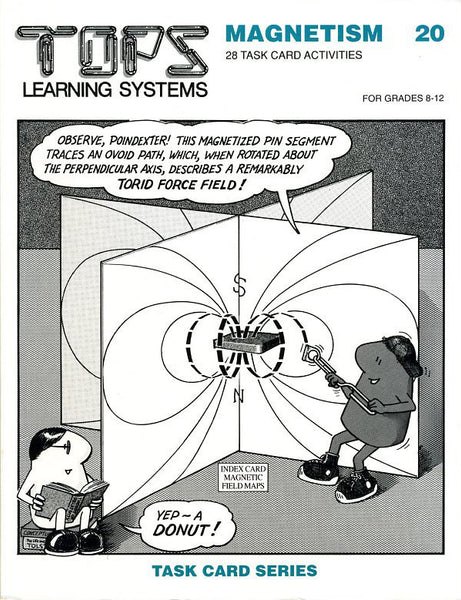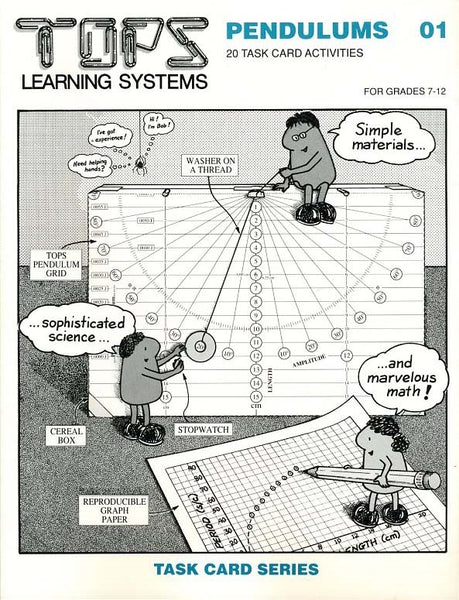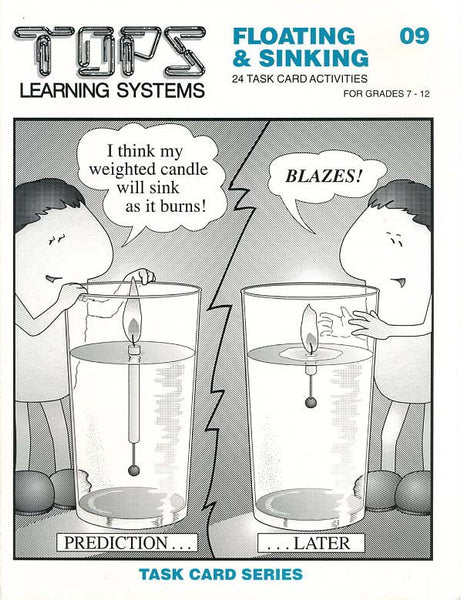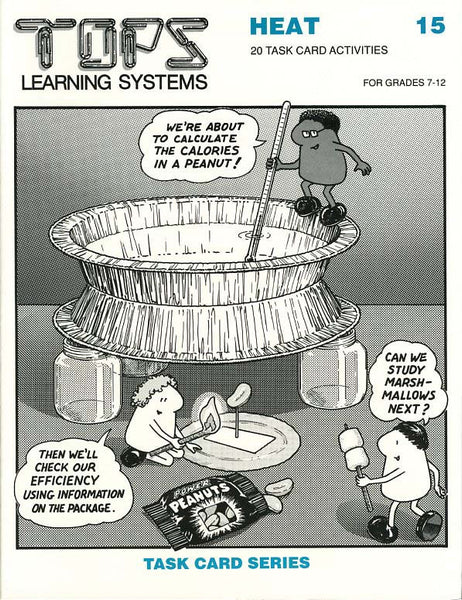#20 Magnetism (grades 8-12)
Regular price $22.95
Soft-bound, 72 page book, 28 reproducible task cards, full teaching notes.
Magnets are fascinating. They provoke our curiosity. Touch a magnet to a straight pin to make another magnet. Hang this pin on a thread to make a compass. Use it to map magnetic fields around a small magnet, or a whole planet. Reverse poles on your pin, chop it into pieces, heat the attracting fragments in a candle flame. These experiments reveal much about the nature of magnetic domains. Create a surprising array of wonderful inventions: electromagnets, solenoids, telegraphs, buzzers, motors, generators and relay switches. What fun (and great science)!
More Information – click any of the tabs below to learn more about this title
Click here for a complete list of materials and convenient shopping.
Key: (1st/2nd/3rd) denote needed quantities: (1st) enough for 1 student doing all activities; (2nd) enough for 30 students working in 10 lab groups all self-paced; (3rd) enough for 30 students working in 10 lab groups, all doing the same lesson. Starred* items may be purchased below.
* 2/20/20: rectangular ceramic magnet* 1/2/2: rolls masking tape
1/10/10: scissors
* 1/2/2: boxes paper clips
* 1/1/1: spool thread
* 2/20/20: wooden spring-type clothespins
* 3/20/30: baby food jars (or small beakers)
1/6/10: meter sticks
5/50/50: blank index cards
* 10/10/10: steel straight pins
* 1/1/1: roll aluminum foil
1/6/10: marking pens, black or other dark color
* 10/100/100: meters thin insulated wrapping wire, 30-32 gauge
* 1/10/10: meters copper or aluminum wire, 20-24 gauge
* 1/1/1: 8 cm pieces of very thin, bare, copper or aluminum wire, 32 gauge or less
1/4/10: medium-sized empty cans
1/4/10: wire cutters
* 1/4/10: candles and matches (or alcohol lamps or Bunsen burners)
* 2/20/20: straight drinking straws
2/20/20: textbooks of equal thickness
1/2/5: exterior windows for tracing onto paper (or light tables)
* 1/4/10: rectangular pocket mirrors (optional)
* 1/1/1: roll clear tape
1/4/10: hole punch
* 0.1/1/1: cup modeling clay
* 1/10/10: size-D dry cells with magnetic outside casings
1/10/10: large paper grocery bag (or heavy wrapping paper)
* 5/50/50: rubber bands, medium width or wider
* 2/10/20: large nails, 3 1/2 inches long
* 50/500/500: washers to fit onto large nails, with holes smaller than the nail head
* 1/10/10: feet wood dowel, 3/16 inches in diameter
2/20/20: thumbtacks
* 1/3/10: gram balances, those improvised in #05 Weighing are suitable
- Lesson 1: To identify and label magnetic poles. To observe how magnets characteristically interact with each other, and with a variety of classroom objects.
- Lesson 2: To establish a stable, repelling force field between magnets. To study its properties.
- Lesson 3: To construct a pin compass. To observe how it can be magnetized and remagnetized to assume different orientations in Earth's magnetic field.
- Lesson 4: To define and measure the angle of declination for various geographic locations. To understand that Earth's magnetic poles are paired with unlike geographic poles.
- Lesson 5: To correctly identify the poles that form at the ends of a pin when it is touched to a permanent magnet. To link together a long chain of pins, by selectively magnetizing the poles of each one.
- Lesson 6: To understand the role of magnetic domains in creating a magnetic field. To predict how dividing or heating these domains affects the field overall.
- Lesson 7: To induce magnetic domains in a pin to align, realign, or randomize, producing various magnetic effects.
- Lesson 8: To learn to map the lines of force surrounding a magnet with a magnetized pin.
- Lesson 9: To map the field of a magnet within a different 2-dimensional plane. To describe the properties characteristic of lines of force.
- Lesson 10: To finish mapping the blank areas on each index card force field. To understand lines of force as having direction.
- Lesson 11: To understand the 3-dimensional nature of a magnetic force field.
- Lesson 12: To map the lines of force between attracting and repelling force fields.
- Lesson 13: To correctly model the relative positions of Earth's magnetic and geographic poles on the surface of a crumpled paper bag "planet."
- Lesson 14: To explore the shape of an Earth-like magnetosphere.
- Lesson 15: To create a magnetic field by sending electricity through a wire coil. To understand how to turn this field on and off, and change its polarity.
- Lesson 16: To investigate the lines of force associated with electricity flowing through a coil.
- Lesson 17: To improvise a galvanometer that tilts in response to an electromagnetic field. To rewire it into an automatic rocker.
- Lesson 18: To build and operate an electromagnet with a removable solenoid.
- Lesson 19: To investigate the electromagnetic properties of a solenoid.
- Lesson 20: To build a working model of a telegraph receiver and key. To understand how it works.
- Lesson 21: To construct a solenoid buzzer. To use a similar design to convert a telegraph into a buzzer.
- Lesson 22: To build a motor that spins by turning itself on and off.
- Lesson 23: To begin construction of a reverse-poles motor.
- Lesson 24: To complete construction of the reverse-poles motor. To understand how it operates.
- Lesson 25: To construct a relay circuit that activates a second circuit. To understand how it works.
- Lesson 26: To generate electricity within an electromagnet by inducing change within the magnetic field of its iron core. To understand the difference between a motor and a generator.
- Lesson 27: To develop a qualitative sense of the relationship between force and distance in a magnetic field. To prepare for a quantitative exploration of the inverse square law.
- Lesson 28: To graph how the force of repulsion between two magnetic poles increases as the distance between them decreases. To confirm the inverse square law.
We encourage improvisation - it's one of the main goals of our hands-on approach! You and your students might invent a simpler, sturdier or more accurate system; might ask a better question; might design a better extension. Hooray for ingenuity! When this occurs, we'd love to hear about it and share it with other educators.
National Science Education Standards (NRC 1996)
Teachers of science...
A: ...plan an inquiry-based science program. (p. 30)
B: ...guide and facilitate learning. (p. 32)
C: ...engage in ongoing assessment of their teaching and of student learning. (p. 37)
D: ...design and manage learning environments that provide students with the time, space, and resources needed for learning science. (p. 43)
• Represent a central event or phenomenon in the natural world.
• Represent a central scientific idea and organizing principle.
• Have rich explanatory power.
• Guide fruitful investigations.
• Apply to situations and contexts common to everyday experiences.
• Can be linked to meaningful learning experiences.
• Are developmentally appropriate for students at the grade level specified.
Core Concepts/Processes: Change in a magnetic field induces electricity, and change in an electric field induces magnetism. • A magnetic field has both forces inversely proportional to distance from the magnet and direction. • The strength of a magnet increases with alignment of its magnetic domains.
Core Inquiries: Inquire into energy transfers: Generate electrical energy with mechanical energy. Do the reverse with a motor.
Core Content:Permanent magnets • Temporary Magnets • Lines of force • Magnetic domains • Angle of declination • Electromagnets • Solenoids • Telegraphs • Buzzers • Motors • Generators • Relay switches • Inverse square law
Core Content: Construct solenoids, telegraphs, buzzers, motors, generators, and relay switches.
Core Content: Hans Christian Orsted (1777-1851) discovers electromagnetism.
TEACHING Standards
These 28 Task Cards promote excellence in science teaching by these NSES criteria:Teachers of science...
A: ...plan an inquiry-based science program. (p. 30)
B: ...guide and facilitate learning. (p. 32)
C: ...engage in ongoing assessment of their teaching and of student learning. (p. 37)
D: ...design and manage learning environments that provide students with the time, space, and resources needed for learning science. (p. 43)
CONTENT Standards
These 28 Task Cards contain fundamental content as defined by these NSES guidelines (p. 109).• Represent a central event or phenomenon in the natural world.
• Represent a central scientific idea and organizing principle.
• Have rich explanatory power.
• Guide fruitful investigations.
• Apply to situations and contexts common to everyday experiences.
• Can be linked to meaningful learning experiences.
• Are developmentally appropriate for students at the grade level specified.
Unifying Concepts and Processes
NSES Framework: Systems, order, and organization • Evidence, models and explanation • Constancy, change, and measurement • Evolution and equilibrium • Form and functionCore Concepts/Processes: Change in a magnetic field induces electricity, and change in an electric field induces magnetism. • A magnetic field has both forces inversely proportional to distance from the magnet and direction. • The strength of a magnet increases with alignment of its magnetic domains.
Science as Inquiry (content standard A)
NSES Framework: Identify questions that can be answered through scientific investigations. • Design and conduct a scientific investigation. • Use appropriate tools and techniques to gather, analyze, and interpret data. • Develop descriptions, explanations, predictions, and models using evidence. • Think critically and logically to connect evidence and explanations. • Communicate scientific procedures and explanations. • Use mathematics in all aspects of scientific inquiry.Core Inquiries: Inquire into energy transfers: Generate electrical energy with mechanical energy. Do the reverse with a motor.
Physical Science (content standard B)
NSES Framework:Magnetism • Properties and changes of properties in matter • Motions and forces • Structure and properties of matter • Interactions of energy and matterCore Content:Permanent magnets • Temporary Magnets • Lines of force • Magnetic domains • Angle of declination • Electromagnets • Solenoids • Telegraphs • Buzzers • Motors • Generators • Relay switches • Inverse square law
Science and Technology (content standard E)
NSES Framework: Abilities of technological design • Understanding about science and technologyCore Content: Construct solenoids, telegraphs, buzzers, motors, generators, and relay switches.
History and Nature of Science (content standard G)
NSES Framework: Science as a human endeavor • History of scienceCore Content: Hans Christian Orsted (1777-1851) discovers electromagnetism.






